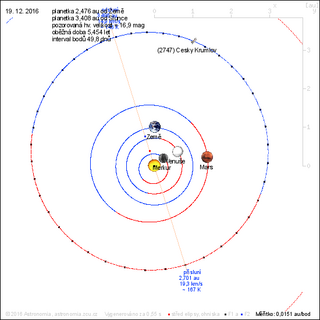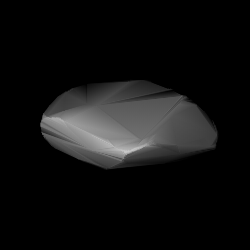
2747 Český Krumlov, provisional designation 1980 DW, is a carbonaceous asteroid and slow rotator from the outer regions of the asteroid belt, approximately 22 kilometers in diameter. It was discovered by Czech astronomer Antonín Mrkos at Kleť Observatory on 19 February 1980, and named for the Czech town of Český Krumlov.
Xanthippe is a dark background asteroid from the central regions of the asteroid belt, approximately 120 kilometers in diameter. It was discovered on 22 November 1875, by Austrian astronomer Johann Palisa at the Austrian Naval Observatory, in what is now Croatia. It is named after Xanthippe, the wife of the Greek philosopher Socrates.

Rhodope is a dark background asteroid from the central region of the asteroid belt, approximately 55 kilometers in diameter. It was discovered on 15 August 1876, by German–American astronomer Christian Peters at the Litchfield Observatory in Clinton, New York, United States. The asteroid was named after Queen Rhodope from Greek mythology.

Erna, provisional designation 1895 CB, is a dark asteroid of the background population in the outer regions of the asteroid belt, approximately 46 kilometers in diameter. It was discovered by French astronomer Auguste Charlois at Nice Observatory on 22 August 1895. The asteroid was presumably named after Erna Bidschof, the granddaughter of Johann Palisa.
2127 Tanya, provisional designation 1971 KB1, is a carbonaceous asteroid from the outer region of the asteroid belt, approximately 40 kilometers in diameter. It was discovered on 29 May 1971, by Russian astronomer Lyudmila Chernykh at the Crimean Astrophysical Observatory in Nauchnij, on the Crimean peninsula. It was named in memory of Tanya Savicheva, a Russian child diarist during World War II.
2026 Cottrell, provisional designation 1955 FF, is a dark asteroid from the inner regions of the asteroid belt, approximately 12 kilometers in diameter.
6433 Enya, provisional designation 1978 WC, is a stony background asteroid from the inner regions of the asteroid belt, approximately 7 kilometers in diameter. It was discovered on 18 November 1978, by Czech astronomer Antonín Mrkos at the Kleť Observatory in the Czech Republic. It was named for Irish musician Enya.
1096 Reunerta, provisional designation 1928 OB, is an asteroid from the background population of the asteroid belt's central region, approximately 40 kilometers in diameter. It was discovered on 21 July 1928, by astronomer Harry Edwin Wood at the Union Observatory in Johannesburg, South Africa. The asteroid was named after South African engineer Theodore Reunert, supporter of the observatory and friend of the discoverer.
1151 Ithaka, provisional designation 1929 RK, is a carbonaceous asteroid from the inner regions of the asteroid belt, approximately 14 kilometers in diameter. It was discovered by Karl Reinmuth at the Heidelberg-Königstuhl State Observatory in 1929, and later named for the Greek island of Ithaca.
1156 Kira, provisional designation 1928 DA, is a stony background asteroid from the inner regions of the asteroid belt, approximately 9 kilometers in diameter. It was discovered on 22 February 1928, by German astronomer Karl Reinmuth at Heidelberg Observatory in southwest Germany. Any reference of its name to a person or occurrence is unknown.
1159 Granada, provisional designation 1929 RD, is a dark background asteroid and relatively slow rotator from the inner regions of the asteroid belt, approximately 30 kilometers in diameter. It was discovered on 2 September 1929, by astronomer Karl Reinmuth at the Heidelberg Observatory in southwest Germany. The asteroid was named for the Spanish city and province of Granada.
6349 Acapulco, provisional designation 1995 CN1, is a dark Adeonian asteroid from the middle region of the asteroid belt, approximately 22 kilometers in diameter.
2033 Basilea, provisional designation 1973 CA, is a stony asteroid from the inner regions of the asteroid belt, approximately 6 kilometers in diameter. It was discovered on 6 February 1973, by astronomer Paul Wild at the Zimmerwald Observatory near Bern, Switzerland. The asteroid was named for the Swiss city of Basel.

1337 Gerarda, provisional designation 1934 RA1, is a dark background asteroid from the outer regions of the asteroid belt, approximately 40 kilometers in diameter. It was discovered on 9 September 1934, by Dutch astronomer Hendrik van Gent at the Union Observatory in Johannesburg, South Africa. The asteroid was named after Gerarda Prins, the wife of an orbit computer at Leiden Observatory.
3184 Raab, provisional designation 1949 QC, is a dark background asteroid and a potentially slow rotator from the central regions of the asteroid belt, approximately 17 kilometers in diameter. It was discovered on 22 August 1949, by South African astronomer Ernest Leonard Johnson at the Union Observatory in Johannesburg. The likely C-type asteroid could have a long rotation period of 275 hours. It was named after Austrian amateur astronomer and software engineer Herbert Raab.
1405 Sibelius, provisional designation 1936 RE, is a stony Florian asteroid from the inner regions of the asteroid belt, approximately 8 kilometers in diameter. It was discovered on 12 September 1936, by Finnish astronomer Yrjö Väisälä at Turku Observatory in Southwest Finland. The asteroid was named after composer Jean Sibelius.
2169 Taiwan, provisional designation 1964 VP1, is a carbonaceous Astridian asteroid from the central regions of the asteroid belt, approximately 17 kilometers in diameter. It was discovered on 9 November 1964, by astronomers at the Purple Mountain Observatory near Nanking, China. It was named for Taiwan.
1323 Tugela, provisional designation 1934 LD, is a dark background asteroid from the outer regions of the asteroid belt, approximately 60 kilometers in diameter. It was discovered on 19 May 1934, by South African astronomer Cyril Jackson at the Union Observatory in Johannesburg. The asteroid was named for the Tugela River in western South Africa.

1632 Sieböhme, provisional designation 1941 DF, is an asteroid and relatively slow rotator from the middle region of the asteroid belt, approximately 27 kilometers in diameter. It was discovered on 26 February 1941, by German astronomer Karl Reinmuth at Heidelberg Observatory in southern Germany. It was later named after ARI-astronomer Siegfried Böhme.
1724 Vladimir, provisional designation 1932 DC, is a rare-type asteroid from the central region of the asteroid belt, approximately 35 kilometers in diameter. It was discovered on 28 February 1932, by Belgian astronomer Eugène Delporte at the Royal Observatory of Belgium in Uccle, Belgium. The asteroid was later named by astronomer Milorad Protić after his grandson, Vladimir.





